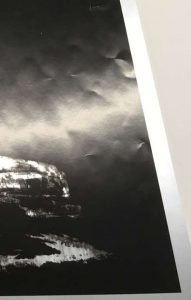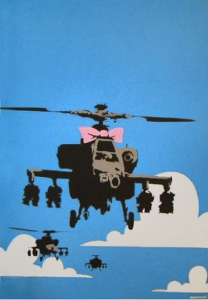
The market for limited edition and signed, original screenprints by the artist Banksy continues to see rapidly rising prices. The value of an individual print, however, is hugely dependent on the prints being in the best possible condition. This means an absence of even slightly dog-eared corners, small creases, old masking tape hinges and, most especially, board backings.
The early Banksy Screenprints were originally offered as affordable art at low prices. The artist even matched dimensions of the paper to fit budget IKEA frames. Some of the papers used for the earlier prints are quite thin and can pick up handling creases easily. Owners often had their prints framed with high street framers who, in order to get prints flat were not averse to using heat set tissue to adhere the print to mount board or, in one case I’ve seen, MDF. The presence of this sort of backing can bring the value down from £20,000 to £1,000.

The darker edge of this paper is due to it being protected from the light by an overlapping mount. It has not stained the paper, rather the rest of the sheet has faded to a brighter white
As the leading experts in the north of England, many clients bring Banksy prints to our studio prior to selling them so we can deal with any issues with the paper. In the past we have worked with a very large, comprehensive collection of Banksy’s prints which has enabled us to become familiar with each of the images, the papers and the variety of inks used. We’ve also picked up bits of information about the printing and signing process which informs any treatment options. For instance, most were signed with graphite pencil, crayon or ink but we have encountered at least one signed with a ‘copy pencil’. This looks just like an ordinary graphite pencil but contains a highly-moisture and solvent sensitive turquoise dye. Micro-testing is required to identify this potentially vulnerable medium.
Dog-eared corners, creases and raised paper fibres can be removed using local or whole sheet treatments to gently flatten them out without leaving the paper too smooth or polished. Many of the prints have blind, embossed stamps as a sign of authenticity and we take great care not to harm their appearance during these processes. Surface dirt and marks can also be removed. Some images, such as versions of ‘Rude Policeman’, have a black, slightly tacky ink referred to as ‘wet’ ink. This can attract dust and we have modified a surface cleaning technique to remove any surface deposits without altering the inks surface.
The studio is fortunate to be equipped with a fume cabinet and a vacuum table. These are essential when lifting prints safely from heat-set and pressure-sensitive backings. Using non-polar solvents, heat set tissues are removed cleanly and any residues of adhesive and masking tape rinsed out on the vacuum table. As many of these tapes have not been in position for long, a conservator can often remove them with warm air and a crepe square, omitting the need for lengthier solvent treatments. Do not attempt to peel off these tapes as even ‘skinned’ fibres on the back of the paper can lower the value and it requires experience to know the type of tape and adhesive.
If putting a print onto the market it is often preferred that the print is unframed so potential buyers can examine the front and back of the sheet. However we also welcome many collectors of prints who require bespoke, museum-quality mounting and framing to both protect their investment and show it in the best possible way. We use 100% cotton, museum-quality mount board and can fit low-reflect, UV-filtering optical glass. A large range of frame styles are available including gessoed and spray-finished mouldings, a choice of hardwoods as well as brushed or polished anodized aluminium frames. We can also match many styles of framing to fit with other artworks in a collection.
We welcome telephone or email enquiries relating to any questions regarding our conservation treatments and services. You can call us on 01765 676600 or email. info@artworksconservation.co.uk
Unable to visit the studio? We use an affordable, art courier service who travel weekly between Harrogate and London and can recommend other courier companies who cover the rest of the UK.














